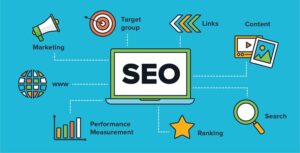1. Introduction
In the vast digital landscape, businesses are continually seeking effective ways to connect with their target audience. Digital marketing services offer a suite of tools and techniques designed to enhance online visibility, engage customers, and drive business growth. As technology evolves, so does the scope and impact of digital marketing.
In today’s fast-paced business world, having a robust online presence is essential for success. Digital marketing services have emerged as the cornerstone for businesses aiming to thrive in the digital era. This comprehensive guide explores the various facets of digital marketing, from SEO to influencer marketing, providing insights into their benefits, strategies, and the evolving landscape.
2. Types of Digital Marketing Services
2.1 Search Engine Optimization (SEO)
SEO stands as the bedrock of any successful digital marketing strategy. From on-page optimization to off-page link-building, SEO plays a pivotal role in improving a website’s search engine rankings, ensuring it’s easily discoverable by the target audience.
2.2 Pay-Per-Click (PPC) Advertising
PPC advertising allows businesses to target specific keywords and pay only when users click on their ads. This targeted approach ensures efficient budget utilization and maximizes return on investment (ROI).
2.3 Social Media Marketing
Utilizing popular platforms like Facebook, Instagram, and Twitter, social media marketing involves creating engaging content, building a brand presence, and fostering meaningful connections with the audience.
2.4 Email Marketing
Direct communication with the audience is facilitated through email marketing. From personalized newsletters to automated campaigns, businesses can nurture leads and maintain ongoing customer relationships.
2.5 Content Marketing
Content is king in the digital realm. Crafting valuable and relevant content, be it blog posts, videos, or infographics, establishes a brand as an authority in its industry.
2.6 Influencer Marketing
Leveraging the reach and authority of influencers, businesses can authentically connect with their target audience, building trust and driving engagement.
3. Benefits of Digital Marketing Services
In an increasingly competitive market, businesses are turning to digital marketing services for a range of benefits.
3.1 Increased Online Visibility
Digital marketing ensures that businesses are easily discoverable by their target audience, leading to increased website traffic and brand exposure.
3.2 Targeted Audience Reach
Through precise targeting and segmentation, businesses can reach the right audience, increasing the likelihood of conversion.
3.3 Cost-Effectiveness
Compared to traditional marketing, digital strategies often prove more cost-effective, allowing businesses to allocate resources efficiently.
3.4 Data-Driven Insights
Digital marketing provides valuable data and analytics, enabling businesses to make informed decisions and optimize their strategies.
3.5 Improved Customer Engagement
Engaging content and interactive strategies enhance customer interaction, fostering brand loyalty and advocacy.
4. SEO: The Backbone of Digital Marketing
4.1 Definition and Importance
SEO involves optimizing a website to rank higher on search engine result pages. A higher ranking leads to increased organic traffic and credibility.
4.2 On-Page Optimization Techniques
From keyword optimization to meta tags, on-page SEO techniques ensure that a website is well-structured and easily understood by search engines.
4.3 Off-Page Optimization Strategies
Building high-quality backlinks and establishing a strong online presence are crucial components of off-page SEO.
4.4 Role in Improving Search Engine Rankings
A well-executed SEO strategy enhances a website’s visibility, driving organic traffic and improving search engine rankings.
5. PPC Advertising: Maximizing ROI
5.1 Overview of Pay-Per-Click
PPC advertising allows businesses to bid on specific keywords and pay only when users click on their ads, providing a measurable and targeted approach.
5.2 Keyword Research and Ad Targeting
Thorough keyword research ensures that businesses target the most relevant and valuable keywords for their products or services.
5.3 Ad Copy Optimization
Crafting compelling ad copy is essential for attracting clicks and encouraging conversions, maximizing the return on investment.
5.4 Monitoring and Adjusting Campaigns
Continuous monitoring and adjustments to PPC campaigns ensure optimal performance and adaptability to changing market conditions.
6. Social Media Marketing: Building Brand Presence
6.1 Utilizing Popular Social Platforms
Choosing the right social platforms ensures businesses connect with their target demographic effectively.
6.2 Content Creation and Posting Schedules
Consistent, quality content shared at optimal times enhances engagement and builds a loyal social media following.
6.3 Engaging with the Audience
Actively participating in conversations, responding to comments, and fostering a sense of community are essential for social media success.
6.4 Analyzing Social Media Metrics
Regular analysis of metrics helps businesses understand what works and what doesn’t, refining their social media strategy for better results.
7. Email Marketing: Direct Communication
7.1 Building and Segmenting Email Lists
Creating targeted email lists ensures that campaigns are relevant and resonate with specific audience segments.
7.2 Crafting Compelling Email Campaigns
Effective storytelling and personalized content increase open and click-through rates, driving desired actions from recipients.
7.3 Personalization and Automation
Automation tools allow businesses to personalize content and deliver timely messages, enhancing the effectiveness of email marketing.
7.4 Measuring Email Marketing Success
Key performance indicators (KPIs) such as open rates, click-through rates, and conversion rates help measure the success of email marketing campaigns.
8. Content Marketing: Storytelling for Brands
8.1 Creating Valuable and Relevant Content
Content marketing involves creating content that provides value to the audience, establishing the brand as an industry authority.
8.2 Blogging, Videos, and Infographics
Diversifying content types ensures a wider reach and caters to various audience preferences.
8.3 Establishing Thought Leadership
Through insightful and authoritative content, businesses can position themselves as thought leaders in their respective industries.
8.4 Connecting with the Target Audience
Understanding the audience’s needs and preferences helps tailor content to resonate with and engage the target demographic.
9. Influencer Marketing: Leveraging Authority
9.1 Identifying and Partnering with Influencers
Choosing influencers aligned with the brand’s values and target audience ensures authenticity and credibility.
9.2 Authenticity and Brand Alignment
Authenticity is crucial in influencer marketing, as consumers respond positively to genuine collaborations that align with their interests.
9.3 Measuring Influencer Campaign Success
Key performance indicators, audience engagement metrics, and sales attribution help measure the success of influencer marketing campaigns.
9.4 Building Long-Term Relationships
Cultivating long-term relationships with influencers fosters continued brand advocacy and loyalty.
10. The Intersection of Digital Marketing Services
10.1 Integrating Multiple Strategies for Synergy
Combining SEO, PPC, social media, and other strategies creates a cohesive and effective marketing approach.
10.2 Creating Cohesive and Comprehensive Campaigns
Case studies of successful integrated campaigns showcase the power of a holistic digital marketing strategy.
11. Trends in Digital Marketing
11.1 Artificial Intelligence and Machine Learning
The integration of AI and machine learning enhances the personalization of content, targeting, and customer experience.
11.2 Voice Search Optimization
Optimizing content for voice search is becoming increasingly important as more users adopt voice-enabled devices.
11.3 Interactive Content
Engaging content formats like quizzes, polls, and interactive videos capture audience attention and encourage participation.
11.4 Virtual and Augmented Reality
The immersive experience offered by virtual and augmented reality presents new opportunities for creative digital marketing campaigns.
12. Challenges in Digital Marketing
12.1 Saturation and Competition
The digital landscape’s saturation poses a challenge, requiring businesses to stand out in a crowded market.
12.2 Changing Algorithms
Search engine and social media algorithms continually evolve, necessitating adaptability in digital marketing strategies.
12.3 Ad Fatigue and Banner Blindness
Consumers’ increasing resistance to traditional advertising methods calls for creativity in capturing their attention.
12.4 Ensuring Data Privacy and Security
As data privacy concerns grow, businesses must prioritize secure and ethical data practices to maintain consumer trust.
13. The Future of Digital Marketing
13.1 Evolving Technologies and Platforms
Continual adaptation to emerging technologies and platforms is crucial for staying ahead in the digital marketing landscape.
13.2 Adaptation to Consumer Behavior Changes
Understanding and adapting to shifts in consumer behavior ensure relevance and effectiveness in marketing efforts.
13.3 Sustainability and Ethical Marketing Practices
With increasing environmental awareness, businesses must embrace sustainable and ethical marketing practices to align with consumer values.
14. Conclusion
In conclusion, digital marketing services are not just a trend but a necessity for businesses aiming to thrive in the digital age. From SEO to influencer marketing, each strategy plays a crucial role in creating a comprehensive and effective online presence. Embracing the ever-evolving landscape of digital marketing ensures businesses stay competitive, connect with their audience, and drive sustainable growth.





